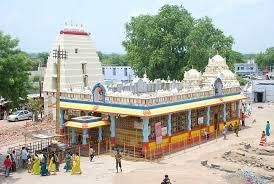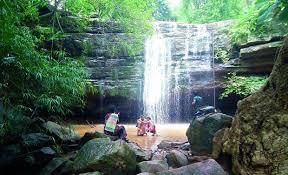TSPSC (Telangana) Exam > TSPSC (Telangana) Notes > Telangana State PSC (TSPSC): Preparation Course > Mahabubabad District (మహబూబాబాద్ జిల్లా)
Mahabubabad District (మహబూబాబాద్ జిల్లా) | Telangana State PSC (TSPSC): Preparation Course - TSPSC (Telangana) PDF Download
History
- The town is situated on the bank of the Pakala River, a tributary of the river Krishna, and holds significant historical and traditional value. Most of the town, villages, and hamlets are inhabited by scheduled tribes (STs), with the Lambadi tribal community being predominant. The residents often communicate in Lambadi or Banjara, a tribal language officially recognized by the Government of India. This language relies solely on oral communication and has no script.
- The name "Mahabubabad" has roots in "Manukota," which is derived from "Mranukota." In Telugu, "Mranu" translates to "Tree," and "Kota" to "Fort," thus signifying "a fort made of trees." Initially abundant with trees resembling a fort, Manukota evolved into Mahabubabad over time. The name transformation occurred when the Nizam ruler Mahbub Ali Khan visited the city. Mahabub, an official under the Nizam's administration, stayed at a place called "Shikarkhana" outside the town during a visit. This historical event led to the renaming of Manukota to Mahabubabad.
Tourist Places
Kuravi Veerabhadra Swamy Temple

- Located in the Kuravi mandal of the Mahabubabad district in Telangana State, India, the historic Sri Veerabhadra Swamy temple is a revered site dedicated to Lord Veerabhadra Swamy. This deity is depicted as fierce-looking with three eyes and ten hands.
- Legend has it that the temple was originally constructed around 900 AD by Bheema Raju of the Vengi Chalukya dynasty and later underwent renovation under the Kakatiya ruler Betharaju I.
- Historical accounts by the renowned traveler 'Marko-Poli' also mention this temple, highlighting its significance as the capital of the Vengi Chalukya Dynasty.
- The Kakatiya kings, known for their devotion to Lord Shiva, were instrumental in constructing and enhancing numerous temples throughout their empire. Peddacheruvu, an expansive area covering 100 acres of land located just one kilometer from the Veerabhadra Swamy temple, holds great potential for transformation into a prominent tourist destination.
Kuravi: A Unique Cultural Hub
- Kuravi boasts a distinctive culture centered around the renowned Lord Veera Bhadra Swami and Bhadrakali temple, attracting both tribal and non-tribal visitors seeking divine blessings.
- The Maha Shivaratri festival stands out as the grandest event in Kuravi, drawing crowds from far and wide.
- Other festivities celebrated in Kuravi include "Bathukamma" and "Bonalu," adding vibrancy to the local cultural scene.
- The villages under Kuravi primarily rely on crops such as cotton and chili, sustaining the local economy.
- Every Monday, a bustling cattle fair (angadi) takes place in the village, where farmers gather to trade their livestock.
Sri Veera Bhadra Swamy: The Divine Figure
- Shri Veera Bhadra Swamy, the eldest son of Lord Shiva, embodies a significant presence in Kuravi's spiritual landscape.
- Accompanied by his brothers Kala Bhairavar, Ganapathy, Karthikeyan, and Swami Iyappan, he symbolizes the ultimate conqueror of the ego.
Historical Insights of the Temple
- Constructed by the illustrious ruler 'Bheema Raju' of the Vengi Chalukya Dynasty, the temple underwent renovation under the Kakatiya ruler 'Betharaju-I'.
- The temple's significance is underscored by references made by the renowned traveler 'Marko-Poli,' positioning it as a pivotal center during the Vengi Chalukya Dynasty's reign.
- The presiding deity, Lord Veerabhadra Swamy, sports a fearsome visage with three eyes and ten hands, embodying power and divinity.
- Annual celebrations like the 'jathra Brahmotsavams' coincide with the grand Mahashivaratri Festival, enhancing the temple's cultural importance.
How to Reach
- The closest airport is Rajiv Gandhi International Airport in Hyderabad, which is 200 km away. The nearest aerodrome is in Warangal, about 60 km away (currently being upgraded to an airport with the joint efforts of AAI and the Government of Andhra Pradesh). Vijayawada Airport is approximately 150 km distant.
- Mahabubabad is well linked to major Indian cities by rail. The town has one of the busiest railway stations on the Kazipet-Vijayawada route. Kazipet serves as the Zonal/Divisional headquarters, about 70 km from Mahabubabad, and is a significant railway junction with a diesel-electric locomotive facility. Kazipet is also known as the "Gateway to North India." Several renowned trains stop at this station, including Charminar Express, Padmavathi Express, Satavahana Express, Intercity Express, Simhapuri Express, Golconda Express, Navjivan Express, Dakshin Express, etc. It is situated 61 km from Warangal and 47 km from Khammam.
- Mahabubabad Bus Station is approximately 11 km away. Auto rickshaws, city buses, and luxury buses operate from the Mahabubabad Bus Station. Mahabubabad, informally known as Manukota, is a place in Mahabubabad District, Telangana State, India. It lies 180 km northeast of Hyderabad, the state capital.
Question for Mahabubabad District (మహబూబాబాద్ జిల్లా)Try yourself: What is the significance of the town Mahabubabad?View Solution
Bheemuni Paadam Waterfalls

- Bheemuni Paadam Waterfalls is located in Seethanagaram Village, GUDUR Mandal, Mahabubabad in the Telangana State, India.
- Approximately 10 km from Gudur Bus Stand, 55 km from Warangal, 88 km from Khammam Bus Station, and 200 km from Hyderabad, lies the picturesque Bheemuni Paadam Waterfalls, nestled within a dense forest. This waterfall, known as Bheema's step, gained attention recently as more adventurous tourists started exploring it.
- Water cascades from a hillock, dropping about 20 feet in a semi-circular enclosure at Bheemuni Paadam. Despite the calming sound of flowing water, the surroundings remain peaceful. The source of the water remains a mystery, although it is occasionally used for local field irrigation even during low flow periods.
- Visitors suggest that with proper facilities and effective marketing by the tourism department, Bheemuni Paadam Waterfalls could become a significant tourist attraction. However, the lack of security is a concern due to the remote nature of the area.
- The location's allure attracts visitors, though security concerns arise due to its secluded nature. It's a picturesque spot, perfect for family outings.
- During sunrise and sunset, the water reflects vibrant rainbow hues, creating a stunning spectacle. Plummeting from a height of approximately 70 feet, the water forms a pool below, particularly robust during the monsoon season. Adjacent to the falls is a cave believed to stretch for about 10 kilometers, adding to its appeal.
- Access to the falls is through dense forests and water streams, approximately 3 kilometers from Bhupathipet between Manoharabad and Narsmapet. From Warangal, take a left turn at Bhupathipet and follow the route via Chinnayellapur.
- Besides the waterfall, nearby lakes offer additional attractions. A small enclosure near the falls houses idols of Lord Shiva and Nagadevatha, where visitors can perform rituals.
- The optimal time to visit is during the monsoon, when the waterfall is at its most spectacular. Weekends and holidays draw a large influx of tourists to this area.
- Yadava Raju, a man with two wives, had a daughter with his first wife. When he visited Papameda Gutha (Hills), his second wife conspired to eliminate his first wife and daughter. She planned to construct a house named "LakhaMedha" using easily flammable wooden sticks. Legend has it that Bheemasena, from the Pandava epic, intervened to divert water to save the first wife and daughter.
- Water flows from the foot of Lord Bheema, creating a mesmerizing display of rainbow colors during sunrise and sunset, a sight rarely witnessed before. The water flowing from Bheema Padam connects and fills three nearby lakes.
- The water from these lakes irrigates agricultural lands, covering approximately 2000 acres on one side and 500 acres on the other annually.
- At Bheemuni Paadam Waterfalls, visitors are captivated by the architectural beauty of the idols of Lord Shiva and Nagadevatha, which hold significant symbolism for many.
How to Reach
- The nearest airport is Rajiv Gandhi International Airport, Hyderabad, approximately 200 km away.
- The nearest aerodrome at Warangal is 60 km away and is undergoing upgrades to airport status through joint efforts of AAI and the Government of Andhra Pradesh.
- Vijayawada Airport is around 150 km from the location.
- The nearest railway station is in Mahubababad, 25 km away.
- From Gudur Bus Stand, it is 10 km away, 55 km from Warangal, 88 km from Khammam Bus Station, and 200 km from Hyderabad.
Question for Mahabubabad District (మహబూబాబాద్ జిల్లా)Try yourself: What is the distance between Bheemuni Paadam Waterfalls and Warangal?View Solution
The document Mahabubabad District (మహబూబాబాద్ జిల్లా) | Telangana State PSC (TSPSC): Preparation Course - TSPSC (Telangana) is a part of the TSPSC (Telangana) Course Telangana State PSC (TSPSC): Preparation Course.
All you need of TSPSC (Telangana) at this link: TSPSC (Telangana)
|
80 docs|74 tests
|
FAQs on Mahabubabad District (మహబూబాబాద్ జిల్లా) - Telangana State PSC (TSPSC): Preparation Course - TSPSC (Telangana)
| 1. What are some popular tourist places in Mahabubabad District? |  |
Ans. Some popular tourist places in Mahabubabad District include Pillalamarri, Lakaram Lake, Kinnerasani Wildlife Sanctuary, and Ramappa Lake.
| 2. How can one reach Mahabubabad District for tourism purposes? |  |
Ans. Mahabubabad District can be easily reached by road from major cities like Hyderabad and Warangal. The nearest railway station is in Mahabubabad town.
| 3. What is the historical significance of Mahabubabad District? |  |
Ans. Mahabubabad District has a rich history dating back to ancient times, with various dynasties ruling the region. It is known for its cultural heritage and historical monuments.
| 4. Are there any accommodations available for tourists in Mahabubabad District? |  |
Ans. Yes, there are various accommodation options available for tourists in Mahabubabad District, ranging from budget hotels to luxury resorts.
| 5. What activities can tourists engage in while visiting Mahabubabad District? |  |
Ans. Tourists visiting Mahabubabad District can engage in activities like boating, wildlife safari, trekking, and exploring historical sites and temples.
Related Searches















